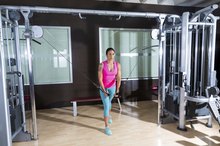What does fact checked mean?
At Healthfully, we strive to deliver objective content that is accurate and up-to-date. Our team periodically reviews articles in order to ensure content quality. The sources cited below consist of evidence from peer-reviewed journals, prominent medical organizations, academic associations, and government data.
The information contained on this site is for informational purposes only, and should not be used as a substitute for the advice of a professional health care provider. Please check with the appropriate physician regarding health questions and concerns. Although we strive to deliver accurate and up-to-date information, no guarantee to that effect is made.
Weight Lifting Requirements for Women in the Workplace
In the United States, there are no universal laws or restrictions limiting the amount of weight that a worker can lift, regardless of the worker's gender. However, federal standards exist that employ a number of factors in computing the maximum weight that a worker can safely lift. These standards suggest a weight limit of 51 lbs. to be lifted with two hands, under ideal conditions, for both men and women.
OSHA Standards
The Occupational Safety and Health Administration, or OSHA, is a part of the U.S. Department of Labor 14. This administration is responsible for creating and enforcing laws that protect workers from potentially hazardous or unsafe conditions. Richard Fairfax, the director of the OSHA's Directorate of Enforcement Programs, states that OSHA does not have standards in place to limit the amount of weight that a worker can lift or carry. Therefore, there are no legal restrictions on the amount of weight that a female worker can lift.
- The Occupational Safety and Health Administration, or OSHA, is a part of the U.S. Department of Labor 1.
- Richard Fairfax, the director of the OSHA's Directorate of Enforcement Programs, states that OSHA does not have standards in place to limit the amount of weight that a worker can lift or carry.
NIOSH Standards
ProForm 830QT Treadmill Weight Limit
Learn More
While OSHA does not have laws in place to prevent female or male workers from lifting dangerously heavy loads, there are federal standards suggesting such limits. Created by the National Institute for Occupational Safety and Health, or NIOSH, these standards serve as nonmandatory guidelines for employers 24. Even though they are not mandatory, these guidelines help to form both the safety standards of individual employers and of OSHA.
NIOSH Lifting Index
To help determine whether or not a load can be lifted safely, the NIOSH has created a formula that takes into account a number of factors related to lifting. These are: the horizontal distance from the midpoint of the load to the midpoint between your ankles; the vertical distance from the beginning to the end of the lift; the angle at which the lift starts and ends, calculated from your midline; the amount of lifts made per minute; the duration of the lift or period of lifting; the quality or lack of handles; and the weight of the load.
Using the NIOSH's equation, a lifting index under 1.0 is acceptable, an index between 1.0 and 3.0 indicates the need for changes to the task and an index greater than 3.0 is unacceptably hazardous 3. These recommendations can be generally applied to male and female workers of all sizes.
- To help determine whether or not a load can be lifted safely, the NIOSH has created a formula that takes into account a number of factors related to lifting.
Examples
Is There a Weight Limit for the Wii Fit?
Learn More
In response to a query from a paramedic required to regularly lift 160-lb. people up and down flights of stairs, Richard Fairfax calculated a lifting index of 3.1 and determined the task to place most workers at risk for injury. As stressed by Fairfax, this is a relatively low estimate based on ideal lifting and grip conditions with ample room to maneuver the body.
NIOSH Standards and OSHA
While there are no OSHA regulations in effect requiring employers to remedy potentially hazardous situations, the Occupational Safety and Health Act contains a clause that may be interpreted as such. Known as the General Duty Clause, it states that employers must supply workers with tasks and an environment free from hazards that may cause serious injury or death. Under this clause, situations such as the one described above may be defined as hazardous for women or men according to the General Duty Clause and based on the NIOSH's lifting index.
Related Articles
References
- Occupational Safety & Health Administration: Standard Interpretations; Richard Fairfax; March 29, 2004
- Centers for Disease Control: The National Institute for Occupational Safety and Health: Ergonomic Guidelines for Manual Material Handling
- Ergonomics: The Revised NIOSH Lifting Equation; Bich Huynh
- Centers for Disease Control and Prevention: The National Institute for Occupational Safety and Health
Writer Bio
Matthew Lee has been writing professionally since 2007. Past and current research projects have explored the effect of a diagnosis of breast cancer on lifestyle and mental health and adherence to lifestyle-based (i.e. nutrition and exercise) and drug therapy treatment programs. He holds a Master of Arts in psychology from Carleton University and is working toward his doctorate in health psychology.









